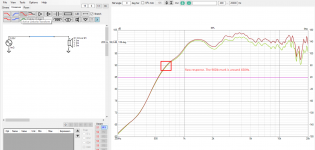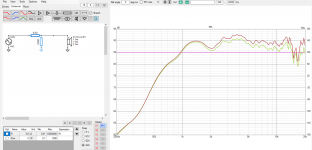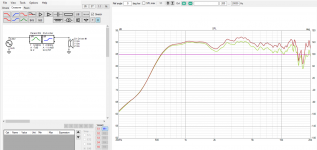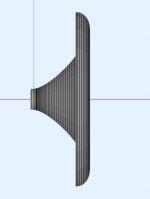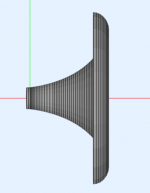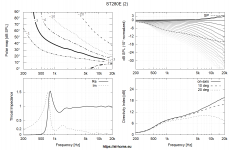Isn't the fight between horn types just silly? isn't it all about how loud the system can play, with or without loading? It seems to be compromise between loading and directivity of the high frequencies, more loading means more "beaming" and vice versa. Why fight about it? If some system requires the loading and is willing to trade-off wide highs then be it.
My current understanding is loading is totally unnecessary at home so it just doesn't matter, better to concentrate on the waveguiding aspect of the device and let loading be what it happens to be. It is important to pay attention what the compromises are to get best possible performance out of each system (design criteria). Here is an example with typical home system with sensitivity around 90db:
On my current setup I need to pad the compression driver ~12db to match woofer below, around 90db system sensitivity. This is about an octave worth of "free" low extension if done by EQ instead of a pad. See the attachments and pay attention to the 90db line. Attachments are:
1. raw response
2. ~90db target sensitivity with a pad
3. ~90db target sensitivity with an EQ.
The same driver that manufacturer suggests to high pass above 1kHz in its intended use (live pa systems) suddenly has response way below 1kHz for home use. High pass would still be needed, but the main thing is there is plenty of sensitivity available for most home systems without loading. If the system sensitivity was above 100db then the loading could be of use, but the whole system would be completely different set of compromises (huge woofer boxes or horns). If I had chosen the loading here for this system instead of "waveguiding" I would need to pad it down, wasted effort, a bad compromise.
My current understanding is loading is totally unnecessary at home so it just doesn't matter, better to concentrate on the waveguiding aspect of the device and let loading be what it happens to be. It is important to pay attention what the compromises are to get best possible performance out of each system (design criteria). Here is an example with typical home system with sensitivity around 90db:
On my current setup I need to pad the compression driver ~12db to match woofer below, around 90db system sensitivity. This is about an octave worth of "free" low extension if done by EQ instead of a pad. See the attachments and pay attention to the 90db line. Attachments are:
1. raw response
2. ~90db target sensitivity with a pad
3. ~90db target sensitivity with an EQ.
The same driver that manufacturer suggests to high pass above 1kHz in its intended use (live pa systems) suddenly has response way below 1kHz for home use. High pass would still be needed, but the main thing is there is plenty of sensitivity available for most home systems without loading. If the system sensitivity was above 100db then the loading could be of use, but the whole system would be completely different set of compromises (huge woofer boxes or horns). If I had chosen the loading here for this system instead of "waveguiding" I would need to pad it down, wasted effort, a bad compromise.
Attachments
Last edited:
+1My current understanding is loading is unnecessary at home so it just doesn't matter, better to concentrate on the waveguiding aspect of the device and let loading be what it happens to be.
Refreshingly sane.
Last edited:
It doesn't matter how you achieve the voltage response on the driver terminals. For the same target SPL response it will be always the same, no matter what's in front of the driver, whether a passive crossover or a DSP EQ, etc. But of course you know this.2. ~90db target sensitivity with a pad
3. ~90db target sensitivity with an EQ.
^ yes this was simplest demonstration I could come up with, I'm using l-pad to get rid of amplifier noise, and can boost the <1kHz with DSP if needed but no need to since I've got to match the directivity and crossover way above 1kHz. If I had bigger woofer I could.
I've got this philosophy for reaching good sound: mind the trade-offs.
If a trade-off is on the sound quality (frequency extension, SPL, what ever the most important reasons are for a system) it better be very important reason why take it, like the one here between loading/beaming. Best sound quality for a given system is achieved when all trade-offs are outside of the design criteria, like in the cost or size or non meaningful audio related issues like SPL capability that is never used. Better sacrifice (trade-off) stuff that is not needed from the beginning, like too much SPL or too much low frequency extension or too wide high dispersion, what ever the important design goals for given system are. One could deliberately factor in too much SPL capability to sacrifice it to reach some design goal, for example. Anyway, here is how to make the best sounding speaker in the world: push all trade-offs from sound to cost and size, then minimize cost and size and you have it 😀
I've got this philosophy for reaching good sound: mind the trade-offs.
If a trade-off is on the sound quality (frequency extension, SPL, what ever the most important reasons are for a system) it better be very important reason why take it, like the one here between loading/beaming. Best sound quality for a given system is achieved when all trade-offs are outside of the design criteria, like in the cost or size or non meaningful audio related issues like SPL capability that is never used. Better sacrifice (trade-off) stuff that is not needed from the beginning, like too much SPL or too much low frequency extension or too wide high dispersion, what ever the important design goals for given system are. One could deliberately factor in too much SPL capability to sacrifice it to reach some design goal, for example. Anyway, here is how to make the best sounding speaker in the world: push all trade-offs from sound to cost and size, then minimize cost and size and you have it 😀
Last edited:
Forgot to add something that derives from the philosophy. Due to very short wavelengths a system has only one shot at good treble performance. Never trade off the treble qualities to anything since there is nothing that can fix it other than change for more suitable tweeter/waveguide.
On the other hand bass extension (and SPL) can traded to something else like better mid range performance because more bass extension/SPL can be added easily due to long wavelengths. System size and cost increases, but this is exactly what we wanted to get better sound isn't it. If one can't increase cost and size due to design criteria it means sound quality can't be increased past the limits. But the limits just need to be acknowledged and accepted and the system design can be perfected for the given criteria. Many thoughts and and easy decision making emerges from the simple philosophy, mind the trade-offs 😉
On the other hand bass extension (and SPL) can traded to something else like better mid range performance because more bass extension/SPL can be added easily due to long wavelengths. System size and cost increases, but this is exactly what we wanted to get better sound isn't it. If one can't increase cost and size due to design criteria it means sound quality can't be increased past the limits. But the limits just need to be acknowledged and accepted and the system design can be perfected for the given criteria. Many thoughts and and easy decision making emerges from the simple philosophy, mind the trade-offs 😉
Last edited:
It's immediately obvious that you actually build something on your own and actually make advances, rather than read the ancient papers all the time. Big difference.
Yes I've been able to make better system prototypes but I'm still listening in mono with noisy electronics so long way to go for The heavenly system 😀 Progress is slow due to responsibilities but the path seems clear. Getting a good system is only matter of time, gotta work out what I actually like and need and what is the tolerance of the family 😀 enjoying and exploiting the freedoms of DIY, having loads of fun testing stuff out when ever there is free time.
Last edited:
Now I realized that to "make advances" means something completely different in English than what I wanted to say 😀 So, you know what I meant.
Yeah, tell me about free time...
Yeah, tell me about free time...
Hehe, yeah there actually is no free time with all the responsibilities. Hobby time comes with cost of bad performance towards family and work and poor night sleep. Aim for hobby that pays so no time wasted in working for salary, still no free time but the need for it is reduced. I've got handful of philosophies 😀
You guys are getting real deep...
I simply asked can I create directivity with a waveguide, that is as strong as the polar shown without exceeding the mouth size of the horn used for the control
Waveguides are obviously focused on guiding waves without creating an significant acoustic load...atleast thats what Ive gathered
This will teach the lesser educated on the topic, how potent a waveguide can be
Mabat is cranking out examples all the time, it would be nice to see what this wave guide would look like vs the tractrix. Maybe we should focus on 800hz, common wave guide territory....
I would think that a waveguide could not create such directivity at 800hz, as in the tractrix. But what do I know...learn me
I simply asked can I create directivity with a waveguide, that is as strong as the polar shown without exceeding the mouth size of the horn used for the control
Waveguides are obviously focused on guiding waves without creating an significant acoustic load...atleast thats what Ive gathered
This will teach the lesser educated on the topic, how potent a waveguide can be
Mabat is cranking out examples all the time, it would be nice to see what this wave guide would look like vs the tractrix. Maybe we should focus on 800hz, common wave guide territory....
I would think that a waveguide could not create such directivity at 800hz, as in the tractrix. But what do I know...learn me
Well, if we are going into philosophy anyway.
The human mind apparently is so powerful that it is able to heal itself from some very nasty diseases by just taking placebos. Proven many times by science.
(it was actually part of my study in applied physics back in the day)
So basically believing into something strong enough can to very special things.
It's also proven that when people very strongly believe in something they can hear it as well. Even when things are physically not there, their brains can't unhear it.
Call it a kind of phantom hearing or something.
So with this same logic, one can also makes himself believe that all of this audio stuff (and I mean ALL of it) is all BS and it all doesn't matter at all.
If you believe that strong enough, everything we just talked about is not relevant anymore.
Happy music listening! 😀
The human mind apparently is so powerful that it is able to heal itself from some very nasty diseases by just taking placebos. Proven many times by science.
(it was actually part of my study in applied physics back in the day)
So basically believing into something strong enough can to very special things.
It's also proven that when people very strongly believe in something they can hear it as well. Even when things are physically not there, their brains can't unhear it.
Call it a kind of phantom hearing or something.
So with this same logic, one can also makes himself believe that all of this audio stuff (and I mean ALL of it) is all BS and it all doesn't matter at all.
If you believe that strong enough, everything we just talked about is not relevant anymore.
Happy music listening! 😀
I don't have tractrix but I can show you two OS-SE waveguides of exactly the same mouth diameter (284 mm), with quite different profiles - as you can see, at least up to 1 kHz (λ ~ 334 mm) the DIs are virtually identical.Mabat is cranking out examples all the time, it would be nice to see what this wave guide would look like vs the tractrix. Maybe we should focus on 800hz, common wave guide territory....
I would think that a waveguide could not create such directivity at 800hz, as in the tractrix. But what do I know...learn me
Attachments
The name of a waveguide / horn profile is not important as long as it fits the system at hand. If tractrix is the name it is nice, if something else then equally nice. Only important thing is to get the system performance one is looking for.
When a project goal is clear in mind it should be relatively easy to find suitable parts/path that enables achieving the goal, which makes a successful project that met the goal. In the end a goal is achieved without too many bad compromises if it was a realistic one to start with and kept clear in mind all the way. A failure should be taken as empowering learning experience and not as a let down.
I'm saying this because sometimes people want stuff with no apparent reason and end up unhappy without ever thinking why they would even need it or what just happened. Just because of wanting something doesn't mean it is what one actually needs, or is something realistically achievable. The children do this all the time, they don't know why they want stuff but if they don't get what they want all hell breaks loose, like having pizza middle of the night in the rural area.
Alright, way too much philosophy for one day 😀 I hope my ramblings reduce the unnecessary pushing of things, they all fit to some projects and for some don't. Hopefully you'll find your device Camplo, or just use what you get your hands on and see how the performance is, might work beautifully even if it was not exactly what you were looking for. A complete system is always better than unfinished one.
When a project goal is clear in mind it should be relatively easy to find suitable parts/path that enables achieving the goal, which makes a successful project that met the goal. In the end a goal is achieved without too many bad compromises if it was a realistic one to start with and kept clear in mind all the way. A failure should be taken as empowering learning experience and not as a let down.
I'm saying this because sometimes people want stuff with no apparent reason and end up unhappy without ever thinking why they would even need it or what just happened. Just because of wanting something doesn't mean it is what one actually needs, or is something realistically achievable. The children do this all the time, they don't know why they want stuff but if they don't get what they want all hell breaks loose, like having pizza middle of the night in the rural area.
Alright, way too much philosophy for one day 😀 I hope my ramblings reduce the unnecessary pushing of things, they all fit to some projects and for some don't. Hopefully you'll find your device Camplo, or just use what you get your hands on and see how the performance is, might work beautifully even if it was not exactly what you were looking for. A complete system is always better than unfinished one.
Last edited:
I don't think it's rambling at all.
Having your design goals and constraints (incl budget) clear at the beginning is a must.
Something most people, and even a lot of engineers seem to skip.
Having your design goals and constraints (incl budget) clear at the beginning is a must.
Something most people, and even a lot of engineers seem to skip.
is this a good article for someone who knows nothing of horn design to learn from? https://www.grc.com/acoustics/an-introduction-to-horn-theory.pdf
I ask because I’d hate to take the time to read and understand something quite complicated and find out later it’s wrong!
I’m trying to follow this thread as I find it quite interesting but need more education to keep up!
I ask because I’d hate to take the time to read and understand something quite complicated and find out later it’s wrong!
I’m trying to follow this thread as I find it quite interesting but need more education to keep up!
Isn't the fight between horn types just silly? isn't it all about how loud the system can play, with or without loading? It seems to be compromise between loading and directivity of the high frequencies, more loading means more "beaming" and vice versa. Why fight about it? If some system requires the loading and is willing to trade-off wide highs then be it.
Good stuff tmuikku,
As a guy whose always trying to stick to the big picture, to understand the tradeoffs better, here's a breakdown i've found helpful when contemplating conical horns for MEH/syns...
Directivity: = wall angles H & V
Freq that pattern control holds down to: = mouth size H & V
Use Keele's formula: freq = 1,000,000 / (dimension in inches x wall angle in degrees)
Size required for freq loading: mouth circumference = 1 wavelength AND horn length = 1/2 wavelength
(some reduced loading occurs down to 1/4 wavelength, then zilch)
By loading, i mean a gain in acoustical output efficiency.
happy to be corrected by horn experts...as i am decidedly not one 🙂
They lead me to believe that there isn't any real tradeoff between high frequency directivity and loading. (tmuikki, i don't get where you're coming from)
Loading seems to be about horn size, both mouth area and length.
Directivity seems to simply be wall angle (and/or horn type, moving away from concials).
And lowest frequency of pattern control is mouth dimensions.
Desired coverage angles and lowest freq of pattern control ends are the deciding factor in my builds so far. Question becomes, how big a horn mouth am i willing to live with, and what kind of weight does that turn into with the horn depth needed by the wall angle patterns.
Hope that all made sense...
The horns i've built so far have all been large enough to load a dcx464 down to it's limit. If we want to use a CD down to it's limit (which i am learning may not be such a good idea), i do think loading might help SQ even at home listening levels by reducing CD excursion at lowest freq of use.
Hello Camplo
These are all rather large and 2" throats but they give you and idea about what can be done directivity wise below 1K or so.
Rob 🙂
2360 Series
These are all rather large and 2" throats but they give you and idea about what can be done directivity wise below 1K or so.
Rob 🙂
2360 Series
Attachments
Last edited:
Mabat thanks for throwing me a bone....if you would go even more extreme placing the fundamental mode where it would be located with the average 200hz horn that would be more relevant to my experiment idea....
Last edited:
mark100: ... They lead me to believe that there isn't any real tradeoff between high frequency directivity and loading. (tmuikki, i don't get where you're coming from)
Loading seems to be about horn size, both mouth area and length.
Directivity seems to simply be wall angle (and/or horn type, moving away from concials).
And lowest frequency of pattern control is mouth dimensions.
I'm no expert on horns, but this seems to be the subject of debate. If loading was something one could tune more or less without affecting the pattern control there would be no debate I reason. HOMs are mentioned, but I don't comment on that because I don't know much about it. Constant directivity is something I understand and appreciate.
I've played with the ATH sims guite many hours and manage to get very smooth looking graphs without diffraction and the loading is something that seems to be the trade-off for this smoothness. Consequently the pattern is rather wide, it is hard if not impossible to tune in constant high DI without issues in the response graphs. Trading off the loading seems to be worth it since there is plenty of sensitivity for home system. I can't comment yet if I prefer higher or lower DI, higher DI would make more sense to eliminate the room as much as possible which I can't treat acoustically (living room) but then I see problems to integrate with the woofer system below so I'm very fine with a bit lower constant DI without any issues, actually can't hope for more for a home system. Except no HOMs, small size, cheap price. ;D
For the short history of home speaker DIY I've had the loading seems to be something not to worry about, it provides sensitivity that I wouldn't need. If it was tunable I'd tune it so that I wouldn't have to use a pad, but the pad is only a gain knob or two resistors so I just don't care about it 🙂 If the system sensitivity needs to be very high then it is a serious problem, to keep the high sensitivity, loading is a must I think, but this would be very big system and there is no need for such thing at home. I take the high sensitivity as valuable asset since I can sacrifice some of it as trade-off to something else.
Everyone got their own desires and goals. I might end up with big high sensitivity system some day and then I'll eat my words but for now big high sensitivity system seems unnecessary with high cost, big size and no benefit audio performance wise in living room situation. Mind you I'm still exploring what is good sound and good system so eating some words is expected in the long term at least 😀
Last edited:
- Home
- Loudspeakers
- Multi-Way
- Is it possible to cover the whole spectrum, high SPL, low distortion with a 2-way?
